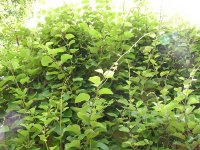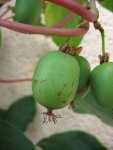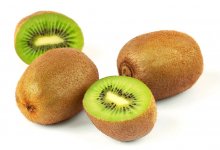Actinidia - actinidia l.
Family actinidiaceae - Actinidiaceae
The botanical characteristics. Woody perennial climbing vines of different sizes. Distributed in the wild, and culture.
Leaves are alternate, simple, serrated. Flowers regular, in racemes, fragrant. It blooms from May to July, fruiting until October. Fruit - berry with numerous seeds, edible, fragrant.
There are some species. The most common are:
- Hardy kiwi - A. arguta Planch. Up to 20 m, bark is light brown. Young shoots smooth in longitudinal lenticels. The leaves are round to oblong-ovate, with a tapered base acute, margin finely toothed, shiny top, naked. The flowers are greenish, dark green fruits, flattened laterally, from spherical to cylindrical.
- Actinidia Kolomikta - A. kolomikta Maxim. Liana up to 15 m with a reddish-brown bark, in his youth in the light of small lenticels, old flaky, thin leaves, dull, oval-elliptic cordate, sharply serrated, along the veins pubescent, on the eve of flowering leaf tips turn white during the fruit formation - turn pink, later becoming crimson. The flowers are white. Fruits rounded light green oblong strips.
- Actinidia polygamous - A. polygama Mig. Height up to 5 m with a reddish-brown bark, in rare large light lenticels. The leaves are oval-pointed, serrated, glaucous on both sides with bristly hairs. The flowers are yellowish. Fruit - light brown, cylindrical, with a tapered spout.
Used parts of the plant. Medicinal raw materials are the fruits, leaves, bark, flowers, collected in the usual way. All parts of the plant contain the alkaloid Actinidia. The cortex contains cardenolides, in stalks - saponins; in leaves - flavonoids, coumarins, vitamins, phenol carboxylic acids, nitrogen-containing compounds; in fruits -. carbohydrates in large amounts (up to 950-1400 mg per 100 g), ascorbic acid, mineral salts, organic acids and other fatty seeds contain oil in its composition and higher fatty acid.
Application. Actinidia fruits are used for a long time under different beriberi. They are used as a prophylactic measure for scurvy, various diseases accompanied by bleeding, infectious diseases and after operations.
In folk medicine, fruits, flowers, bark is used in colitis, tuberculosis, whooping cough, dental caries, in the treatment of lumbago, gonorrhea, rheumatism, paralysis, dizziness, headaches, as a mild laxative, expectorant.
Preparation Actinidia "Poligamol" is an effective way to increase urine output, as a tonic with loss of strength. It is used to strengthen the heart. Tincture used for angina.
In Chinese, Korean and Japanese medicine, the fruits are used in a variety of respiratory diseases, as a diuretic, laxative, with a shortage of vitamins in the body, especially in old age.
preparation
- For infusion take 20 g of flowers, leaves or fruits, crushed, pour 200 ml of boiling water and insist on a boiling bath for 15 minutes, cooled 45 minutes, filtered, take 1/3 cup 3 times a day.
- To take a decoction of 15 g bark, crushed, pour 180 ml of boiled water, in a water bath for 30 min., Cooled, 10 min., Filter. Take 2 tbsp. spoon 2-3 times a day after meals.
- Fresh juice take 1-2 Art. spoon 3-4 times a day.





Comments
Commenting, keep in mind that the content and the tone of your messages can hurt the feelings of real people, show respect and tolerance to his interlocutors, even if you do not share their opinion, your behavior in terms of freedom of speech and anonymity offered by the Internet, is changing not only virtual, but real world. All comments are hidden from the index, spam control.